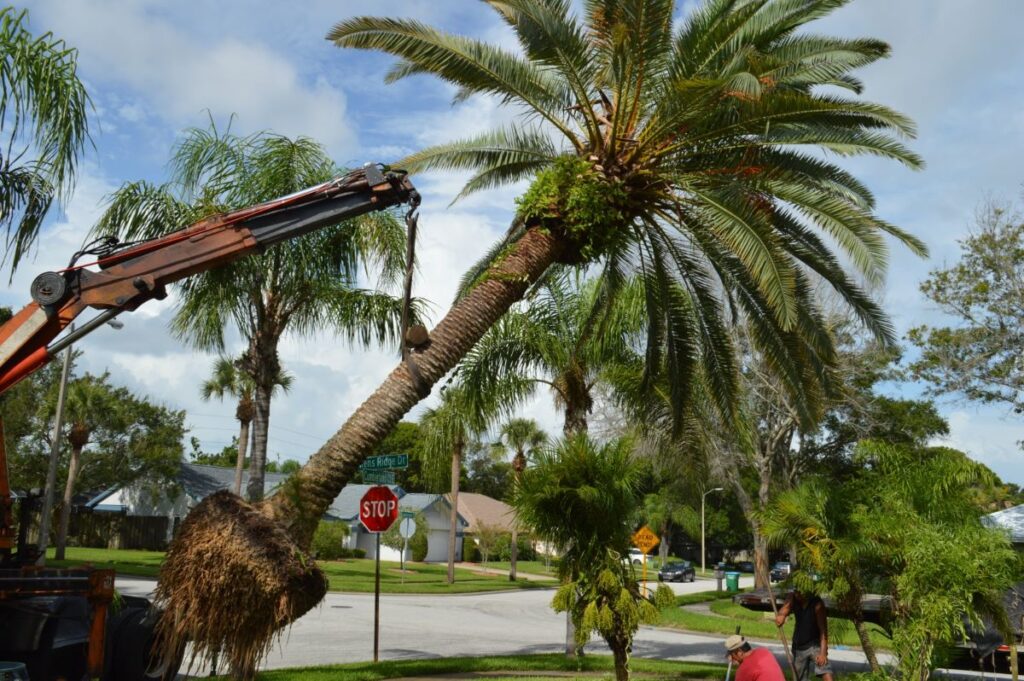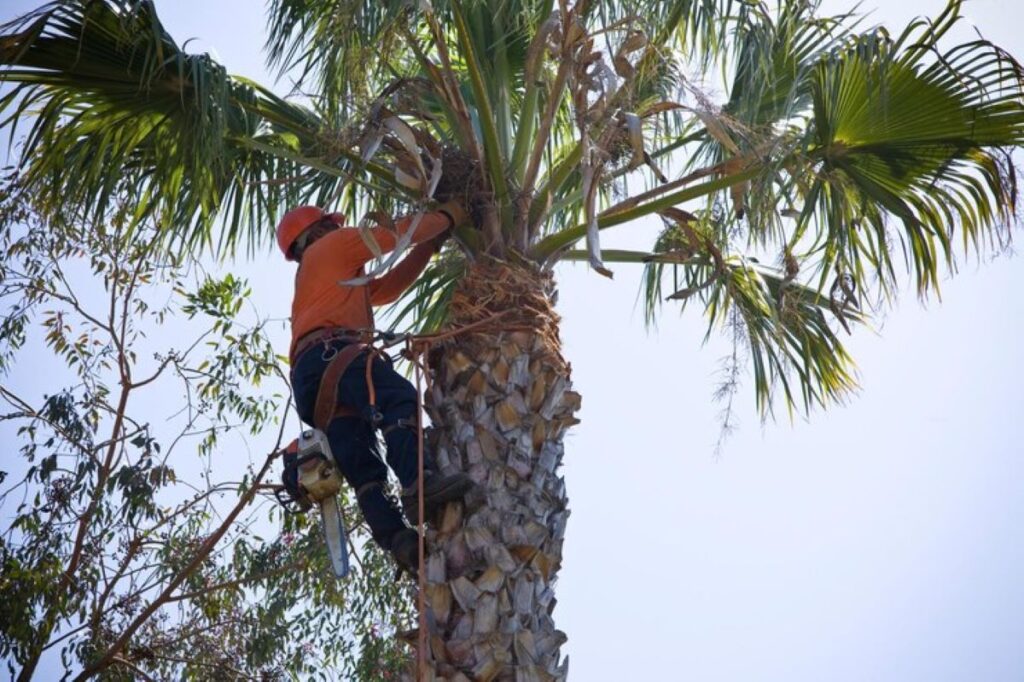Removing a palm tree requires skill, carefulness, and specific knowledge to ensure safety and protect the landscape. These tall trees, while stunning, can be tricky to remove because of their height, weight, and complicated root systems.
Professional tree removal experts stress several important aspects of palm tree removal:
- Safety First: Following safety measures to protect property and people
- Right Tools: Using specialised tools made for palm tree removal
- Expert Evaluation: Thoroughly assessing the condition of the tree and its surroundings
- Legal Compliance: Following local council rules and obtaining necessary permits
A successful palm tree removal operation not only gets rid of the tree but also protects the surrounding area. Dead or sick palm trees can pose serious dangers to nearby buildings and individuals, making professional removal crucial for maintaining a safe environment.
This guide delves into expert advice and tried-and-true methods for removing palm trees, based on the extensive experience of certified arborists in dealing with these unique trees.
Understanding Palm Tree Maintenance
Regular palm tree maintenance is essential for keeping your landscape healthy. When properly cared for, palm trees have vibrant leaves, steady growth, and a strong structure. This not only enhances the tropical look of your property but also prevents any potential dangers.
Essential Maintenance Practices
Here are some key practices to include in your palm tree maintenance routine:
- Annual health inspections
- Regular frond trimming
- Soil quality monitoring
- Disease prevention checks
- Structural stability assessment
The proper technique for trimming dead fronds requires precision and care. Dead or yellowing fronds should be cut close to the trunk without damaging the trunk tissue. A clean, sharp cutting tool helps prevent tears that could create entry points for diseases or pests.
Safe Trimming Guidelines
When trimming palm tree fronds, keep these guidelines in mind:
- Use sterilised cutting tools
- Cut at a 45-degree angle
- Maintain 2-3 inches distance from trunk
- Remove completely brown fronds only
- Preserve green fronds for photosynthesis
The timing of palm tree maintenance plays a crucial role in their health. Late spring presents the ideal period for major trimming activities, as palms enter their active growth phase. This timing allows the tree to heal efficiently and reduces stress on the plant’s system.
Optimal Maintenance Schedule
Here’s a breakdown of when to perform specific maintenance tasks on your palm trees:
- Spring: Major trimming and cleaning
- Summer: Light maintenance and health monitoring
- Autumn: Preparation for winter protection
- Winter: Minimal intervention unless emergency
Professional arborists recommend maintaining a consistent maintenance schedule throughout the year. This proactive approach helps identify potential issues early, reduces the risk of pest infestations, and maintains the palm’s natural growth pattern while preserving its structural integrity.
The Role of Professional Tree Services in Palm Tree Care
Professional tree services bring specialised expertise essential for maintaining the health and beauty of palm trees. Certified arborists possess in-depth knowledge of different palm species, their growth patterns, and specific care requirements.
Species-Specific Expertise:
- Recognition of palm varieties native to different regions
- Understanding unique nutritional needs of each species
- Identification of species-specific diseases and pests
- Knowledge of growth rates and mature sizes
Certified arborists apply scientific methods and proven techniques to:
- Assess palm tree health through detailed inspections
- Diagnose potential issues before they become severe
- Implement targeted treatment plans
- Monitor growth patterns and responses to care
Professional Palm Tree Care Benefits:
- Precise trimming techniques that protect against disease
- Expert handling of heavy fronds and seed pods
- Prevention of structural damage to nearby buildings
- Enhanced property value through aesthetic maintenance
Professional tree services utilise specialised equipment and safety protocols to:
- Access tall palm crowns safely
- Remove dead fronds without damaging healthy tissue
- Shape palms while preserving their natural form
- Apply treatments at correct heights and angles
The aesthetic enhancement achieved through professional care includes:
- Balanced crown development
- Uniform frond arrangement
- Clean trunk appearance
- Proper spacing between trees
Professional arborists also maintain detailed records of:
- Treatment histories
- Growth patterns
- Seasonal changes
- Response to interventions
These records help create customised care plans that ensure long-term palm tree health while maintaining visual appeal.

Considerations and Techniques for Safe Palm Tree Removal
Safe palm tree removal requires careful planning and precise execution to protect both property and the environment. A comprehensive site assessment identifies potential hazards and establishes appropriate safety protocols.
Critical Safety Considerations:
- Power line proximity and electrical hazards
- Building structures within falling distance
- Underground utilities and root system interference
- Soil stability and ground conditions
- Weather conditions and wind patterns
- Access points for equipment and removal vehicles
Risk Mitigation Strategies:
- Establish clear safety zones with proper barricading
- Remove fronds systematically from top to bottom
- Use appropriate rigging techniques for controlled sectional removal
- Position equipment on stable ground away from root zones
- Implement traffic control measures for street-side removals
Environmental Protection Measures:
- Conduct wildlife habitat assessments before removal
- Time removals outside nesting seasons
- Install root barriers to protect adjacent vegetation
- Implement erosion control methods
- Minimise soil compaction through designated access paths
- Recycle palm materials for mulch or composting
The removal technique varies based on the palm’s size and location. Smaller palms might allow for straight felling, while larger specimens require sectional dismantling. Each cut must account for the palm’s unique fibrous structure and potential stored energy.
Professional equipment selection plays a vital role in environmental protection. Low-impact machinery and specialised cutting tools help preserve surrounding landscape features. Proper disposal methods ensure removed palm materials benefit local ecosystems through recycling programmes.
Site restoration post-removal includes soil amendment and erosion prevention measures. These steps maintain landscape stability and promote healthy regrowth in the affected area.
Specialised Equipment and Techniques Used by Experts in Tall Palm Removal
Professional palm tree removal requires specific tools and machinery designed for handling these unique trees. The equipment selection directly impacts the safety and efficiency of the removal process.
Essential Specialised Equipment:
- Crane Systems: Heavy-duty cranes with extended reach capabilities lift and manoeuvre tall palm sections
- Rigging Equipment: Specialised ropes, pulleys, and cables designed for precise directional control
- Aerial Work Platforms: Cherry pickers and boom lifts provide safe access to elevated cutting points
- Professional-Grade Chainsaws: High-powered saws with specific bar lengths for different trunk diameters
Advanced Removal Techniques:
- Strategic cutting points identification
- Weight distribution calculations
- Precise angle measurements for controlled drops
- Property Protection Measures
- Protective ground mats for heavy machinery
- Temporary barriers around work zones
- Root ball extraction equipment to prevent soil disruption
The combination of specialised equipment and expert techniques ensures minimal impact on surrounding structures. Professional arborists utilise laser measuring devices to calculate precise falling distances and implement hydraulic bracing systems for added stability during removal operations.
Safety Equipment Integration:
- Impact-resistant debris netting
- Ground protection systems
- Advanced communication devices
- Load-bearing calculation tools
These specialised tools require extensive training and certification for proper operation. Licensed arborists understand the specific requirements for different palm species and sizes, adapting their equipment selection accordingly.
Selling or Removing Palms: Options to Consider After Removal
Removing a palm tree can be an opportunity for homeowners to find ways to recoup some of the costs involved through different methods of getting rid of the tree. If the palm tree is healthy and can be used again, it can be quite valuable in the landscaping market. Here are some potential buyers who may be interested:
- Residential landscapers looking for mature palms
- Commercial properties needing an immediate visual impact
- Nurseries wanting to increase their stock
- Property developers working on new projects
The value of a removed palm tree in the market depends on several factors:
- How rare the species is
- The overall health condition of the tree
- Its size and age
- The condition of its root ball
- The demand during that particular season
Disposal Options for Removed Palms:
1. Direct Sale
- List on marketplace websites
- Contact local nurseries
- Advertise to landscaping companies
2. Repurposing
Instead of discarding the trunk sections, consider repurposing them into garden features, creating natural stepping stones, or using them as decorative mulch.
3. Green Waste Processing
For those unable to sell or repurpose their palm trees, there are environmentally friendly options available. Homeowners can utilize green waste processing services such as professional mulching services, council green waste collection, or composting facilities.
Working with certified arborists ensures proper removal techniques that preserve palm value for resale. Professional removal services often maintain connections with buyers and can facilitate sales transactions, maximising the return on removal investments.
Conclusion
Removing a palm tree is not just about cutting it down; it’s a task that requires skill, knowledge, and the right tools. When done correctly, it can enhance the beauty of your landscape and even increase the value of your property.

Why Professional Help Matters
While some might consider DIY methods for palm tree removal, the risks involved make it a job best left to professionals. Certified arborists have the training and experience to:
- Remove trees safely without causing damage to nearby structures or plants
- Navigate local laws and regulations regarding tree removal
- Choose the most effective technique based on the specific type of palm tree
The Benefits of Expert Removal
When you hire experts for palm tree removal, you’re investing in more than just a service. You’re ensuring that:
- Your landscape remains intact and visually appealing
- Any potential issues with property value are addressed
- Surrounding vegetation is protected from harm
- Environmental impact is minimised
In short, professional palm tree removal is an investment in both your property and the environment. With their specialised skills and equipment, certified arborists can carry out removals with utmost care—preserving the beauty of your landscape while prioritising safety.
Related : Residential Hedge Trimming: Maintaining Your Garden’s Look
